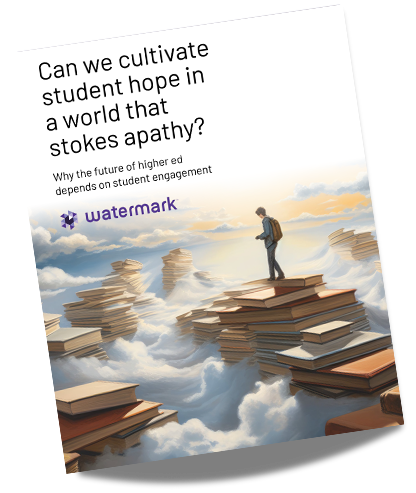Can we cultivate student hope in a world that stokes apathy?
As a higher education administrator, you undoubtedly spend a lot of time thinking about the vitality of your institution. Yet the amount of attention you give to target numbers, dollars, and percentages must be in balance with the attention you give to something less tangible: student engagement. Defined by The Glossary of Education Reform, student engagement is “the degree of attention, curiosity, interest, optimism, and passion that students show when they are learning or being taught, which extends to the level of motivation they have to learn and progress in their education.” In short, student engagement is at the heart of learning and of institutional longevity.
Since student engagement is the fuel that keeps higher education running, its opposite, student apathy, is a significant roadblock. Apathy worsens academic performance, diminishes student satisfaction, and deflates retention rates. This was particularly evident during 2020, when the disruptions of the pandemic tanked student engagement and, along with it, student enrollment and retention. Today, schools are still slowly crawling their way out of the crater left by such an impact. Higher ed administrators like you are tasked with addressing this persistent issue — you must create an environment that fosters inspiration and motivation. But how?
Think back to the last time you felt truly excited to learn something. Were you at school? With friends or family? In solitude? The setting may vary, but in every case it did something to activate your excitement — about the nature of reality and your ability to navigate it, about who you could become, or about the future you might create. In other words: it gave you hope.
“Hope can be a powerful force,” writes fantasy author Laini Taylor. “Maybe there’s no actual magic in it, but when you know what you hope for most and hold it like a light within you, you can make things happen, almost like magic.”
Learn more about why the future of higher ed depends on student engagement.
Download Now

A global pandemic. Political upheaval and economic uncertainty. Mental health struggles. Skyrocketing higher educational costs. Unprecedented climate change. It is impossible to consider student engagement without considering hope — and the ways that today’s students have had theirs thwarted. In the past few years alone, students have lived through seismic societal and personal shifts.
At worst, these years have brought students trauma that will have far-reaching effects. At minimum, they have contributed to a profound sense of numbness and resignation to occupying an increasingly scary, challenging world. Understandably, it is difficult for many students to imagine a version of their lives that will be made much brighter by achieving a college degree.
In this eBook, we outline 10 strategies for cultivating hope and empowerment in students. Read on to learn how you can help combat student disengagement and build a vibrant, active campus community while increasing retention rates.

Involving students in decision-making processes related to their education and campus life can enhance their sense of ownership and responsibility. Empowering students to voice their opinions and contribute to the campus community fosters engagement and motivation.
Student councils:
Establish student councils that represent the student body and provide a platform for student input. Councils can address student concerns, propose initiatives, and collaborate with administrators.
- The University of Texas at Austin’s student government launched the “UT Outpost” initiative, a campus food pantry and career closet designed to combat food insecurity and help students with professional attire. This initiative provided free groceries and business clothing to students in need, supporting their overall wellbeing and success.
Participatory committees:
Create participatory committees that involve students in key decisions related to curriculum design, campus policies, and event planning. These committees can enhance transparency and inclusivity.
- At Penn State, student participation is encouraged by the principle that “individuals who are directly affected by decisions should have the opportunity to participate appropriately in making those decisions.” Getting the student perspective will help your student body feel heard and provide helpful insight to guide your committee.
Feedback surveys:
Conduct regular feedback surveys to gather student opinions on various aspects of campus life. This critical information can help higher ed leaders determine the success of new technology, the satisfaction of faculty performance, and the effectiveness of new campus services. Use this information to make informed decisions and improvements on your campus.
- San Diego State University, Georgia State University, and Northern Arizona University used information gleaned from student feedback surveys to invest in several changes on campus. Some of these changes included expanding the virtual campus, appointing student-success advisory teams, and promoting career readiness.
Want to consistently improve response rates when soliciting feedback?
Consider going digital. A software that seamlessly integrates with your campus learning management system and uses notifications, reminders, and pop-ups reliably drives strong response rates. Many students prefer to complete their evaluations on mobile devices, so make sure your platform adapts to any device.
2. Bolster support services
Providing robust academic and mental health support services is essential for helping students overcome obstacles that might contribute to apathy, thereby increasing retention rates. Support services can address a wide range of student needs and promote overall well-being.
Tutoring:
Offer tutoring services that provide individualized academic support. Tutors can help students understand difficult concepts, improve study skills, and prepare for exams.
- Peer tutoring programs are effective, low-cost, and provide students with leadership opportunities. If your institution does not have peer tutoring already, consider setting up this program on your campus.
Wellness centers:
Wellness centers — which usually have some combination of a gym, field house, outdoor lawn,or recreation center — provide students a place to exercise, build community, and improve mental wellbeing.
- Research from George Mason University found that “students who used the campus wellness center more frequently reported fewer depressive symptoms compared to those who rarely or never used the facility.” Wellness centers can improve students’ mental health, helping them feel happier, more satisfied, and better motivated in their studies.
Mentoring:
Implement mentoring programs that connect students with faculty, staff, or peer mentors. Mentors can offer guidance, support, and encouragement throughout students’ academic journeys.
- As part of Haywood Community College’s strategic plan to address enrollment retention, they built in targeted outreach enabled by innovative Watermark software solutions. “Prior to Watermark products, we would typically experience well over 200 students on our nonpay list who would end up being purged before a semester started,” said Michael Coleman, D.B.A., Vice President of Student Services/CIO at the college. “With the targeted outreach and texting potential available in Watermark’s Student Success & Engagement platform, we are able to interact with the students better, which means creating campaigns to proactively influence decision-making. We weren’t utilizing text messages and we weren’t able to realize the potential such communication strategies could have on student engagement and success.”
Using predictive analytics to identify students who need support
Solutions that employ predictive analytics can identify students in need of assistance while defining the obstacles those students face. Insights uncovered in student data such as test scores, attendance, and socioeconomic and demographic factors can help identify each student’s risk level, pinpoint when intervention is necessary, and help institutions provide personalized support before it’s too late.
3. Establish clear relevance
Demonstrating the real-world applications of academic content can increase student motivation and engagement. When students see the relevance of what they are learning, they are more likely to invest effort and take their studies seriously.
Guest lectures:
Invite industry professionals to deliver guest lectures and share their experiences. These insights can help students understand how their coursework applies to real-world scenarios.
- By the time a student is in college, they have been in classrooms for over a decade, many having limited — if any — experience in the workforce. Bringing in industry professionals to discuss possible career paths can help these students visualize what life will be like after graduation and encourage them to complete their degree.
Internships:
Organize internships and cooperative education initiatives within your institution’s programming that provide students with hands-on experience in their chosen fields. Internships can bridge the gap between theory and practice.
- Northeastern University is renowned for its cooperative education (co-op) program, which integrates full-time, paid work experiences into the academic curriculum. Students alternate between semesters of academic study and semesters of professional work in their field of study. This approach reinforces the relevance of academic content and significantly boosts students’ employability by providing them with real-world experience before graduation. Unlike typical internships, this program offers students multiple opportunities to work globally, fostering practical skills and international exposure that enhance employability.
Practical examples:
Use practical examples like case studies or in-class exercises to illustrate the application of theoretical concepts. These examples can make abstract ideas more concrete and relatable.
- In a business ethics course, for example, a professor might use the real-world case study of the Enron scandal to illustrate theoretical concepts. Students would analyze decisions made, discuss ethical dilemmas, and propose alternative actions. By dissecting a tangible example, abstract ideas like corporate responsibility and ethical decision-making become more concrete, relatable, and easier for students to understand and apply.
4. Provide professional development for faculty
Training faculty in best practices for student engagement and motivation is crucial for creating an engaging learning environment. Faculty members play a significant role in inspiring and connecting with students.
Workshops and training:
Offer workshops and training sessions that focus on innovative teaching methods, classroom management, and student engagement strategies. These sessions can help faculty enhance their teaching skills.
- The University of California, Berkeley, has implemented the Teaching Excellence Colloquium for new faculty. These workshops equip faculty with innovative, evidence-based teaching strategies and cover topics like the science of how students learn, effective course design or redesign, active learning, and aligning relevant tech with instruction.
Peer collaboration:
Encourage faculty to collaborate and share best practices with their peers. Peer collaboration can lead to the exchange of ideas and the development of effective teaching strategies.
- At the University of Wisconsin-Madison, the Teaching Academy Fellows Program brings faculty together in interdisciplinary groups to collaborate on teaching strategies and course development. Participants share best practices, offer peer feedback, and work on joint projects aimed at enhancing student engagement and learning outcomes. This collaborative approach helps faculty innovate and refine their teaching methods through shared experiences.
Growth at every step of faculty’s professional path
You can support your faculty with tools that simplify documenting achievements, streamline annual reviews, and provide valuable insights for promotion and tenure. Enable ongoing professional development through centralized data tracking and reporting, ensuring each faculty member’s journey is supported by real-time insights and seamless collaboration.
Student feedback:
Incorporate student feedback into faculty development programs. Understanding students’ perspectives can help faculty identify areas for improvement and adjust their teaching approaches.
Roanoke-Chowan Community College nearly tripled their course evaluation response rates using Watermark Course Evaluations & Surveys. Using the platform’s robust analytics has empowered faculty to gain insights into student experiences and instructional effectiveness. This data-driven approach allows the college to tailor professional development initiatives, resulting in more engaging and effective teaching that directly aligns with student needs.
5. Foster a sense of belonging
Creating an inclusive campus environment where every student feels valued and connected is fundamental to combating apathy. Students are more likely to engage and persist in their studies where they feel they belong.
Diverse student organizations:

- The University of Chicago has a number of organizations focused on culture, religion, identity, music, dance, and more. These clubs help students feel welcome on campus, leading to a better student experience. Clubs don’t have to cost an arm and a leg, either. By letting organizations spearhead fundraising and budgeting efforts, institutions can keep their own costs low while promoting student leadership.
Inclusive events:
Host events that celebrate cultural diversity and promote inclusion. These events can range from cultural festivals and guest speakers to community service projects and social gatherings.
- The University of Michigan hosts an annual Taste of Culture event that invites students to explore the diverse cultural backgrounds present on campus through food, music, and performances. This event not only showcases the rich cultural diversity of the student body but also fosters cross-cultural understanding and a stronger sense of belonging among students from different backgrounds.
Support services:
Offer support services such as mentorship programs, peer support groups, and mental health centers. These services can help students navigate challenges and feel more connected to the campus community.
- For institutions with limited resources, providing adequate mental health support on campus is often a challenge. Incorporating mindfulness into existing programming, creating student support groups, and implementing on-campus referrals to address non-clinical cases are ways to meet students’ needs without adding too much of a financial strain on your institution.
6. Use active learning techniques
Make learning more captivating by working with instructors and professors to employ active learning methods in your programs. Active learning shifts the focus from passive reception of information to active participation and collaboration. Here are some examples of active learning techniques that educators can implement in their classrooms.
Group projects:
Encourage students to work on group projects that require collaboration, problem-solving, and critical thinking. These projects can foster teamwork and communication skills.
- Though group projects may be universally dreaded, they teach students valuable skills that are necessary for the workforce. In this article, Christina Katopodis, senior postdoctoral research associate at the City University of New York’s Humanities Alliance, explains how instructors can improve group projects by “thoughtfully structur[ing] the work in equitable ways.” Here’s how she recommends getting started:
- First: Teach students collaboration skills and project-management strategies.
- Second: Clearly lay out the workload and set expectations
- Third: Remember that every step actually has 10 steps beneath it. Break down the smaller steps of the process as it pertains to your classroom. Set time aside to review those steps with your students before a group project starts.
Class discussions:

- How can you get quiet or apathetic students to participate in class discussions? This research conducted by Brown University outlines how higher education leaders and instructors can foster an environment where every student feels safe to speak their mind. Some tips include emphasizing approachability, addressing reasons for non-participation, experimenting with different participation formats and modalities, and inviting student selfassessment for participation.
Hands-on activities:
Incorporate hands-on activities such as experiments, simulations, and fieldwork. These activities provide practical, real-world experiences that make learning more relevant and exciting.
- At Stanford University, the d.school (Hasso Plattner Institute of Design) has been a pioneer in implementing hands-on, project-based learning. Students engage in real-world projects that require them to empathize with users, define problems, ideate solutions, prototype, and test their ideas. This active learning approach has not only enhanced student engagement but also helped students develop critical problem-solving skills applicable across various fields.
7. Personalize learning experiences
Tailoring educational experiences to individual student needs and interests can significantly enhance engagement and motivation, leading to higher retention rates.
Data analytics:
Use data analytics to gain insights into student preferences, performance, and learning styles. This information can guide the development of personalized learning plans and support services.
- Watermark and the North Carolina Community College System (NCCCS) partnered to research whether technology-enabled success coaching could close equity gaps in higher education. This study, called the Minority Male Success Initiative (MMSI), tracked the results of 11 participating institutions that used the Watermark Student Success & Engagement software solution and hired success coaches to improve student outcomes. Empowering institutions to strategically align people, processes, and technology led to improved student outcomes for vulnerable student populations, including an over 22 percent retention increase among new, minority-male, full-time students in pursuit of an associate’s degree.
Academic support:
Ensure your institution offers personalized academic support, such as one-on-one tutoring, customized study plans, and adaptive learning technologies. These resources can help students overcome academic challenges and succeed in the long term.
- As part of the MMSI, each college hired dedicated success coaches. Frank Raya-Viera was a student participant at Nash Community College. With the support of his success coach, Jamal Pitt, Frank was able to graduate from Nash Community College and transfer to East Carolina University to pursue a degree in computer science. When asked about his experience being coached by Pitt, Frank said, “I wouldn’t be successful without him.”
Career counseling:

- The University of Illinois Chicago’s college of Liberal Arts and Sciences created a course entirely focused on career development. This course led to such positive results with the students, the career development office was recognized with the esteemed Career Readiness Excellence Award from the National Association of Colleges and Employers. By incorporating career counseling into their program, UIC was able to boost student engagement and the prestige of the university.
8. Encourage extracurricular activities
Promoting involvement in extracurricular activities is essential, even for institutions with limited financial resources. Extracurricular activities can provide students with a sense of purpose, enhance their college experience, and foster a strong sense of community.
Clubs and organizations:
Encourage students to join or create clubs and organizations that align with their interests.
With a small or dwindling budget, institutions can support these groups by offering shared meeting spaces, leveraging digital platforms for communication, and encouraging partnerships with local businesses or community organizations for sponsorships or resources.
Sports and recreation:

nstitutions can focus on low-cost, highimpact options like intramural sports or fitness challenges that utilize existing campus facilities. Engaging students in activities such as running clubs, yoga sessions, or outdoor adventure groups can improve mental health and reduce stress, all while keeping expenses minimal.
Arts and culture:
Promote involvement in arts and cultural activities such as music, theater, and visual arts in creative and cost-effective ways.
Unfortunately, extracurricular activities in the arts may be among the most likely to lose funding as institutions face budget restraints. Colleges and universities can get creative to keep these initiatives afloat. For example, schools might repurpose unused spaces into pop-up art studios, organize virtual exhibitions, or host performances and workshops through online platforms.
9. Recognize and reward engagement
Acknowledging and rewarding student participation and achievements can be a powerful motivator. Recognition can take various forms, from formal awards to informal praise.
Non-academic achievements:
Celebrate achievements in non-academic areas, such as leadership, community service, and extracurricular involvement. Acknowledging these contributions can boost students’ confidence and sense of accomplishment.
- The University of Maryland’s Do Good Challenge is an annual competition that encourages students to develop innovative projects for social impact. By recognizing and rewarding initiatives in community service and entrepreneurship, the university highlights the importance of non-academic contributions and motivates students to engage in meaningful, real-world problem-solving.
Public recognition:
Use platforms such as social media, newsletters, and campus events to publicly recognize and celebrate student achievements. Public recognition can inspire peers and foster a culture of appreciation.
- At Arizona State University, the “Pitchfork Awards” is an annual event that celebrates student achievements across various categories, including leadership, community service, and campus involvement. The event not only recognizes outstanding students but also publicly showcases their contributions to the university community. The use of social media and university platforms to highlight these achievements further reinforces a culture of engagement and motivates other students to get involved.
10. Seek out innovative technology
Utilizing modern technology and digital tools can enhance learning experiences and make education more dynamic and appealing, positively impacting retention rates. Technology can facilitate interactive learning and provide new opportunities for engagement.
Online platforms:
Use online platforms and learning management systems to deliver course content, facilitate discussions, and provide resources. These platforms can make learning more accessible and flexible.
- Arizona State University (ASU) uses its advanced online platform, ASU Sync, to deliver a hybrid learning experience. This platform allows students to attend live classes remotely, access course materials, and participate in discussions. The flexibility and accessibility provided by ASU Sync help ensure that students can engage with their coursework wherever they are.
Virtual reality:

- The University of Illinois at Urbana-Champaign has integrated virtual reality (VR) into its curriculum, allowing students, for example, to engage in immersive simulations of complex engineering concepts. This innovative use of technology not only enhances students’ understanding of theoretical concepts but also provides them with practical, handson experience in a virtual environment.
Gamification:
Implement gamification techniques such as educational games, quizzes, and simulations. Gamification can make learning more enjoyable and motivate students to engage with the material.
- Drexel University has integrated gamification into its online courses through the use of interactive simulations and game-based learning modules, making learning more engaging while allowing students to apply theoretical knowledge in a practical, competitive environment.
Are you giving your students an education worth having?
“An education is not so much about making a living as making a person.”
— Tara Westover, Educated












